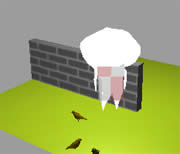Collision Detection
Using modelsUnderRay
 This tutorial
builds on the last. So, you will need your completed Director file. If you
want to download the completed one, it is available here (3Denv_collision1.dir).
This tutorial
builds on the last. So, you will need your completed Director file. If you
want to download the completed one, it is available here (3Denv_collision1.dir).
2. Add the following to the top of the script:
-- reference character's bounding box
property pCharBoundingBox
Often when setting up collision detection between complex models, a simplified mesh is created around the model to define the collision area. This is what we're going to do with our character model.
3. Add the following to the end of the beginSprite handler.
createCharacterBoundingBox
4. Add the following to the script.
on createCharacterBoundingBox
-- create model resource
charModRes = \
p3Dmember.newModelresource("charModRes",#box)
charModRes.height = 25
charModRes.width = 25
charModRes.length = 50
-- create model and reference to it
pCharBoundingBox = \
p3Dmember.newModel("CharBoundingBox",charModRes)
pCharBoundingBox.worldPosition = \
pCharacter.worldPosition
pCharacter.addChild(pCharBoundingBox, \
#preserveWorld)
boxShader = \
p3Dmember.newShader("transparentShad",#standard)
boxShader.transparent = TRUE
-- set opacity of shader 0 is invisible
boxShader.blend = 50
pCharBoundingBox.shaderList = \
p3Dmember.shader("transparentShad")
end
 In the above script
we created a bounding box for the character with its position corresponding
to the character model. The box was made a child of the character so it
would always move with it. A shader was created with the transparent
property on (TRUE). This allows the blend property
to be set to less than 100%. Setting the blend
to 0 will make the model invisible. For now, we set it to 50% so we can
see the bounding box (as in the pic).
In the above script
we created a bounding box for the character with its position corresponding
to the character model. The box was made a child of the character so it
would always move with it. A shader was created with the transparent
property on (TRUE). This allows the blend property
to be set to less than 100%. Setting the blend
to 0 will make the model invisible. For now, we set it to 50% so we can
see the bounding box (as in the pic).
-- register the member for regular timeMS events in
-- order to respond to user input and resolve camera
-- collisions i.e. after specified time segments
-- activate collisionDetect handler
p3Dmember.registerForEvent(#timeMS,#collisionDetect,me,1000,10,0)
In the above statement me is the scriptObject
parameter and indicates the collisionDetect handler
is in the same script as the registerForEvent
command. 1000 is the begin
parameter and indicates that the first time the collisionDetect
handler is to be activated will be 1 second (or 1000
milliseconds) after the registerForEvent command
has occurred. 10 is the period
parameter and indicates the subsequent time interval (in milliseconds) for
the collisionDetect handler to be activated. 0
is the repetitions parameter and indicates the
#timeMS event will occur indefinitely. Using 0
for repetitions makes the period parameter
insignificant (it will be ignored).
6. Delete the createCollisionDetect
handler and replace it with the following:
on collisionDetect me
-- create a list to store collision data created by
-- modelsUnderRay and cast ray to left
collisionList = \
p3Dmember.modelsUnderRay(pCharBoundingBox.worldPosition, \
-pCharacter.transform.yAxis,#detailed)
In the above statement, we create a list (collisionList),
to hold the information generated by the modelsUnderRay
command. #detailed is used for the levelOfDetail
parameter and will return a list of property lists, each representing
an intersected model. #distance is one of the
properties that will appear on the property list, which, in our case, represents
the distance from the character to the point of intersection with the model.
-- if ray picks up models, then activate
-- checkForCollion handler and send the
-- collisionList as a parameter
if (collisionList.count) then \
me.checkForCollision(collisionList[1])
-- cast ray to right
collisionList = \
p3Dmember.modelsUnderRay(pCharBoundingBox.worldPosition, \
pCharacter.transform.yAxis,#detailed)
-- if ray picks up models, then check for collision
if (collisionList.count) then \
me.checkForCollision(collisionList[1])
-- cast ray forward
collisionList = \
p3Dmember.modelsUnderRay(pCharBoundingBox.worldPosition, \
pCharacter.transform.xAxis,#detailed)
-- if ray picks up models, then check for collision
if (collisionList.count) then \
me.checkForCollision(collisionList[1])
-- cast ray backward
collisionList = \
p3Dmember.modelsUnderRay(pCharBoundingBox.worldPosition, \
-pCharacter.transform.xAxis,#detailed)
-- if ray picks up models, then check for collision
if (collisionList.count) then \
me.checkForCollision(collisionList[1])
end
on checkForCollision
me, collisData
This handler is activated when a model is picked up by modelsUnderRay.
The statement we used above:
me.checkForCollision(collisionList[1]) - - dot syntax
is equivalent to
checkForCollision me, collisionList[1] - - verbose syntax
So, collisionList[1] is assigned as a value to
the parameter thisData.
-- grab the #distance value from the CollisionList
dist = collisData.distance
-- check if distance is less than bounding box width
if (dist < pCharBoundingBox.resource.width/2) then
-- get distance of penetration
diff = pCharBoundingBox.resource.width/2 - dist
-- calculate vector perpendicular to the wall's
-- surface to move the character using the
-- #isectNormal property
tVector = collisData.isectNormal * diff
-- move the character in order to resolve the
-- collision
pCharacter.translate(tVector,#world)
end if
end
7. Play the movie and test what you just created. If you want to remove the bounding box, change the blend to 0.
You can download the completed movie from here.

